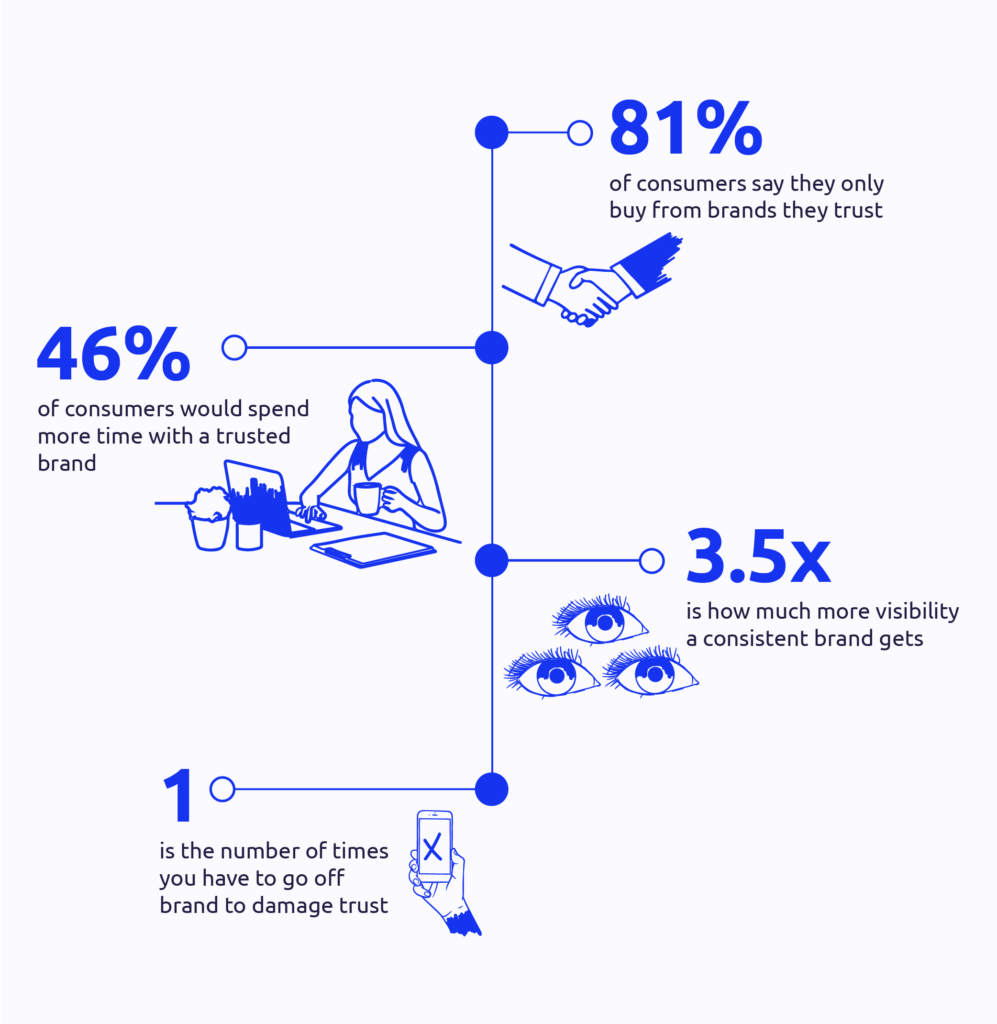
Building brand trust isn’t your responsibility (it’s everyone’s)
The nirvana for any company or organisation is brand trust. It secures loyal customers who keep coming back for more, driving your sales and revenue. What more could you want?
Often, building and protecting brand trust is left solely in the hands of marketing and brand teams.
But, in today’s world, a lot of people are likely creating and distributing brand materials. This is especially true in organisations like charities, franchises and membership networks where many teams may be responsible for marketing.
It only takes someone to make one wrong move and brand trust is damaged. That’s why it’s no longer sensible to have one department responsible for brand.
You need to bring everyone on board for ultimate trust. This blog will tell you why and, most importantly, how.
Why should everyone in your org be responsible for brand trust?
Brand trust is the result of consistency. Your brand needs to share the same messaging, visuals and tone of voice across your channels. By doing so, your audience will begin to understand who you are, your relevancy and whether you’re trustworthy.
Let’s say your organisation is on brand 90% of the time. That’s great. But then someone puts out a social post that doesn’t align with your guidelines. The wrong colours are used, the logo isn’t featured and they’ve used a tone of voice unlike all your other posts.
If that post is the first time someone comes across you, it won’t leave a good or lasting impression. Nor the foundations for brand trust.
Your existing leads will also be confused (if they recognise you at all). It becomes harder for them to build favourable connotations about your brand, which will threaten their ability to trust you. Your professionalism is also undermined.
Other brand trust stats to know

Consistency will also increase your visibility by up to 3.5 times, so keeping everyone aligned makes it easier to attract people too.
Add to this that 65% of consumers say a brand’s CEO and employees influence their decision to buy. It means that everyone in the organisation has an impact on whether your customers choose to trust and eventually purchase from you. It’s only right, then, they all do their part.
Finally, ensuring everyone enforces brand trust will ease the pressure on your marketing personnel. Otherwise, you rely on them to create all your customer-facing materials or process requests from other teams.
It leaves limited capacity to focus on strategic work that drives your bottom line further. It could also lead to errors slipping through the net from overworked marketing teams who don’t have the time to govern everyone else.
The benefits of brand trust
So, we’ve established why everyone should be responsible for brand trust. But why does it matter?
The answer is that people will only choose brands they trust. Research shows 81% of consumers must trust a brand before they consider buying anything. A further 46% would spend more with those they trust.
Other benefits include:
- Increased customer loyalty. Trusting customers are more likely to remain loyal to a brand and make repeat purchases.
- Improved brand reputation. A trusted brand will be viewed positively and recommended to others.
- Better customer engagement. Trust leads to greater customer engagement and a more positive customer experience.
- Reduced marketing costs. Building brand trust reduces the need for costly marketing campaigns. People will come to you regardless!
- Competitive advantage. A trusted brand has a competitive advantage over its untrusted rivals in the market, so you get a better market share.
So, brand trust is crucial in driving sales, revenue, profit and customer satisfaction. These should all be key drivers for everyone working within your organisation.
How to bring everyone on board with brand
If you work in marketing, you’ve likely been praying for the day everyone gets on board with brand. But it’s often easier said than done. You need to find ways to inspire people and keep them on the right path.
Luckily, we’ve put together some of our top tips to help.
1. Communicate the benefits
The first step to bringing everyone on board is ensuring they are aware of the rewards. This will highlight why brand trust – and by extension, branding consistency – matters.
We’ve already given you some useful stats in this blog that should help. It’s also worth breaking it down so it’s specific to their roles and goals.
For example, if you’re talking to your sales team, you might discuss the increase in sales and leads associated with brand trust. If you’re a charity dealing with fundraising teams, convey how being trusted could help them meet fundraising goals. If you’re marketing a franchise, make sure franchisees know how their branch will perform better.
By putting it into terms that move their individual performance needles, people are more likely to act.
2. Circulate strong brand guidelines
We’ll say it again: consistency is crucial to trust. For everyone to play their part in building trust, you need to keep them on-brand.
Having strong brand guidelines is key. They should include information such as:
- Your brand colours
- Fonts
- Logo (and how it should be used)
- Other imagery
- Tone of voice – the words you use to describe yourself and how you speak to customers
- How your branding should be used on different channels/content types
Once you’ve got guidelines, you need to circulate them across your organisation. Anyone creating brand assets should have access to ensure their designs are aligned.
But it’s a challenge in itself to keep people on brand, even if they’ve got guidelines in front of them. Which brings us to our next tip…
3. Use brand templates
If you’re working with people who don’t have design experience, brand templates are an ideal solution.
Essentially, you create templates for your different content types. They should only need minor adjustments when being used. For example, text and imagery might change, but the other elements will remain the same.
By using templates, people will know what their materials should replicate. It’ll also make their lives much easier as there’s less work to do. They’ll be more inclined to stay on brand and create great content.
Remember to be careful when creating templates as, if you’re not careful, you risk people moving things about when you don’t want them to. You’ll also need to make them user-friendly if you want people to use them correctly.
4. Use a brand management platform
A brand management platform is incredibly valuable if you want easy-to-use templates for your organisation.
It uses templates across your content types which embed your brand guidelines and keep people on the right track. Templates are also responsive and easy to update to find the user’s needs. But those crucial brand elements are locked down to avoid any deviation.
There will also be added elements that empower great brand designs beyond templates. These include approval workflows or collaborative processes. So, people can create brand assets that help build trust themselves, while giving you the ability to govern and approve what’s been made before it goes out.
It means anyone can become a brand hero and protect customer trust, despite their skill level or job title.
How RightMarket makes it easy for everyone to protect brand trust
We know that brand trust is important. But it only comes from a consistent and strong brand that connects with customers.
RightMarket is the brand management platform that brings everyone in your organisation on brand. Our user-friendly templates allow any user to create professional-looking materials regardless of their role.
We even have a Tone of Voice Assistant that’ll guide them to use the right words for better customer experiences all-round.
The result is consistent communication across all your channels that meets your customers’ expectations and gains their trust.
By giving your organisation the tools to create brand materials, you’ll enable everyone to fulfil their responsibility in building a strong, trustworthy. Everyone benefits from the rewards – and your job becomes a lot easier too.
Book a demo today
To find out howRightMarket can protect your brand across the organisation, so you can build that all-important trust.